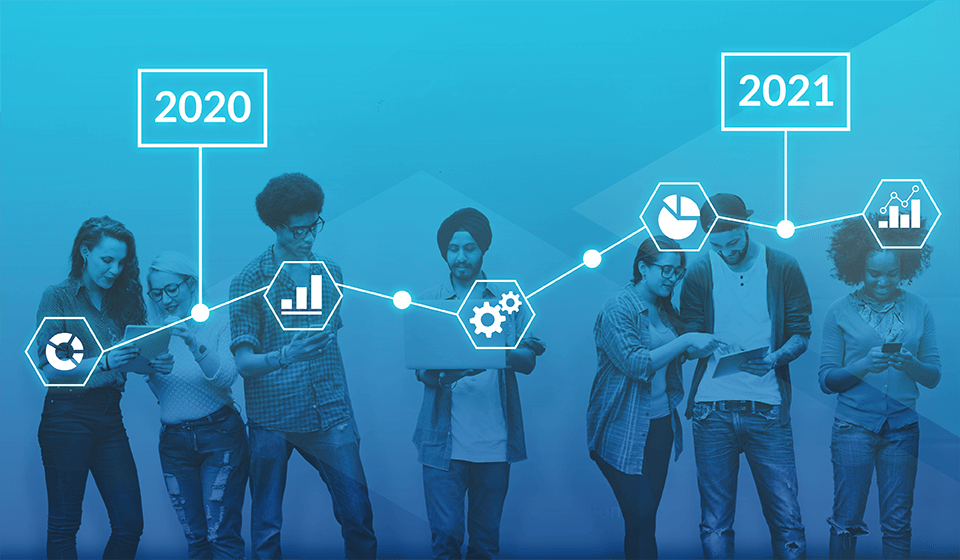The disruptions caused by COVID-19 have forced companies to reinvent themselves in dozens of ways, including how they invest in and execute analytics capabilities. Across industries and geographies, companies are “adopting and scaling AI and analytics much more rapidly than they previously thought possible” in direct response to the disruptions caused by COVID-19, according to a November 2020 McKinsey analysis.
Now, we’re collectively facing a future where remote work is normalized, and the next global disruption is just over the horizon. Analytics decision-makers need long-term solutions not only to support new, insights-driven roles in their organizations but also to amplify business preparedness in the face of future disruptions.
5 Emerging Best Practices As Analytics Continues to Evolve
By Q4 2020, more than 60% of firms globally had chief data officers (CDOs), Forrester reports, “and for the first time since we’ve started measuring insights-driven business maturity … fewer than half of organizations rank as [analytics] ‘beginners.’” To get a firmer grasp on this evolving landscape, let’s examine the prevailing cultural and analytics trends of business in 2020—identifying what we learned and what will prevail as new best practices in the years to come. We believe the following five strategies will instill confidence in your employees as you support them with flexibility and resiliency under any circumstances.
1. Business leaders will adopt a long-term, formal approach to managing remote work.
Despite an abrupt shift in early 2020 to remote work environments, companies and their employees are embracing strategies and technologies that take remote activity into account as a default. With greater security, accessibility, and self-service capabilities, leading companies are even exceeding normal levels of user performance. As we observed in April 2020, companies are “not only improving how users access critical analytics features but also enriching their experiences and results in the process.”
Business leaders can start by envisioning full cycles of decision-making processes taking place in a single, common digital environment. When team members’ touchpoints intersect, insights and decision-making happen faster and more effectively, even from different locations.
2. Data science and business teams will collaborate more effectively with each other.
Collaborative features built directly into business intelligence tools have grown abruptly in their adoption, despite years of delayed progress. In collaborative environments that support self-service, data storytelling, and democratized data access, once tedious interactions between data scientists and business users are becoming streamlined. Employees who haven’t seen their colleagues for 8 to 10 months have nonetheless managed to collaborate successfully as a result.
In their AI and analytics predictions for 2021, PwC notes that “the top [analytics] choices … have one thing in common: They cross the entire organization.” Indeed, we observed in May 2020 that analytics tools that span the organization help employees develop and share the insights they need, securing better decision-making capabilities even among geographically dispersed teams. Decision-makers must invest in democratized data and governance that support cross-department collaboration, and they must improve once-manual processes through dedicated tools.
3. Data leaders will continue building a culture of trust with a singular analytics platform—a ‘single version of the truth’ for the entire organization.
Analytics has established itself in the minds of employees who witnessed its resiliency and value in a year of otherwise great uncertainty. Employees expect business leaders to implement analytics as part of a unified effort, creating a “single version of the truth” on which all employees can rely.
Democratizing data access, streamlining governance, and providing individualized interfaces and tools for a wide range of employees will be central to this process. Leading companies have already realized early successes in building a new culture of trust and are expanding those successes among more and more teams.
4. Employees of all stripes will familiarize themselves with data storytelling and even master it as a new, essential skill.
Data storytelling—the act of making sense of data and analytics insights and then conveying that wisdom to other team members—has become a must-have, acquired skill among non-data scientists in leading organizations. As early as March 2020, we observed how data “narratives” would become increasingly important to decision-making processes, especially for employees who rely on other colleagues—team leaders, for example—with analytics access.
In November 2020, McKinsey observed that analytics that support “explainability” are boosting employee confidence in analytics and improving operations—even contributing to a 15% uplift in earnings from AI and analytics initiatives. Leading organizations will formalize data literacy (understanding data), data storytelling (sharing data insights with others), and features that “explain data” to users as they continue to build organizational trust.
5. Companies will continue their migration of analytics to the cloud.
Analytics tools that support private cloud and hybrid deployments—including analytics access from remote environments—are now critical investments in the new decade. That’s because cloud-based analytics tools are essential if companies are to deliver on all the above priorities and capabilities.
Business leaders must remain user-oriented in their adoption of cloud-based analytics, prioritizing multi-tenant solutions that cover a wide range of demands but remain approachable for business users. Tools that provide these capabilities with more agile governance and management will be paramount to successful decision-making at all levels of the organization.
A Look at What’s Next
Business leaders acknowledge that COVID-19 accelerated analytics initiatives they already had in place but had simply delayed until they become essential. This was the ruin of too many companies and could be again under similar, future circumstances.
We should not ignore 2020’s silver linings—namely, the lessons we’ve learned about the impact of global disruptions on business. Empowering employees with simple and secure access to analytics applications alongside other business-critical resources is essential to not only enduring future crises but to ensuring ongoing success—no matter the conditions.













